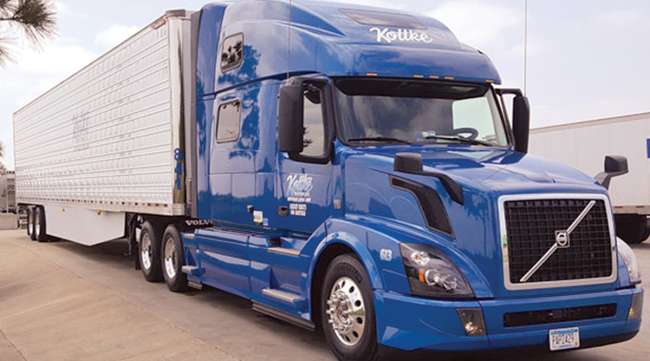Most Truckload Carriers Expect to Report Lower Earnings in Second Quarter

The truckload industry continued to struggle in the second quarter and earnings are expected to be down year-over-year for most carriers, based on forecasts from industry analysts and interviews with several fleets.
Analysts cover 16 out of the 17 publicly-traded truckload companies; the exception is Patriot Transportation Holding. Meanwhile, Schneider National Corp. and Daseke Inc. went public this year and don’t have year-over-year comparisons.
Roadrunner Transportation Systems Inc. and Celadon Group Inc. withdrew earlier quarterly earnings reports and haven’t set a timeline for when they’ll reissue their results, although both are expected to record year-over-year declines of more than 50%. Schneider, Roadrunner, Celadon and Daseke rank Nos. 6, 15, 33 and 42, respectively, on the Transport Topics Top 100 list of the largest North American for-hire carriers.
Of the remaining 12 companies, eight are expected to announce profits declined year-over-year.
USA Truck, No. 70, is projected to lose money for the sixth straight quarter, although less than year-ago losses.
Analysts forecast only three truckload carriers will increase profits versus 2016 levels. Werner Enterprises Inc., No. 16, is due to have profits rise a few percentage points, and Landstar System, No. 9, and Forward Air Corp., No. 37, could have double-digit gains.
Most large and medium-sized fleet executives told Transport Topics that April was slower than normal, May was better and June was strong.
“Overall we’re not optimistic that second quarter numbers will be very good for anybody,” said Dave Rusch, CEO of No. 19 CRST International Inc. “We saw what happened in the first quarter with deteriorating operating ratios at most of the publicly traded companies and I think that’s going to be the same trend for the second quarter.”
He said that the flatbed divisions — CRST Malone and BESL — are out of capacity and rates have risen 15% within the last six months.
“But longhaul [dry] van, expe- dited, drayage and dedicated operations have been very, very slow. It’s not good, but not deplorable. It’s just okay at best. Getting rate increases are just difficult. We’re running into a lot of resistance. Rates at CRST Expedited, Specialized Transportation Inc. and Pegasus Transportation are flat year-over-year,” he said.
Nevertheless, the Cass Freight Index rose year-over-year 7.1% for shipments and 7.4% for expenditures in May. Sequentially, shipments rose 4.3% and expenditures were up 0.9%. The index, which uses information from bill payments through Cass Commercial Bank in St. Louis, is based mainly on trucking data but also includes air, rail and barge freight.
“Throughout the U.S. economy, there is a growing number of data points suggesting that the economy continues to get slightly better. Some data points are simply less bad, but an increasing number of them are better, and even a few are becoming outright strong,” noted Donald Broughton of Cass.
However, Barry Pottle, CEO of Pottle’s Transportation, told Transport Topics that he didn’t notice a significant uptick until after Memorial Day. The Bangor, Maine-based dry-van carrier has 180 trucks.
“April was slow and May was bad, too. There really wasn’t any activity going around. But in June, we saw the phones ringing more and there have been more opportunities out there. One customer — we do about 60 loads a week with them — wanted to up the capacity and we’re doing about 100 loads a week. It seems like things are starting to get better,” Pottle said.
Often there is a seasonal spike between Memorial Day and July 4 when the produce season reaches its peak and retailers stock up on outdoor products.
Kyle Kottke, general manager at Kottke Trucking, described volume and pricing in the quarter as “hit or miss” and the overall environment as “mediocre.” He described April as rough, May as a step in the right direction and June as robust, although overall results were slightly down compared with 2016. The Buffalo Lake, Minn., dry-van and refrigerated carrier has about 175 trucks.
“Activity in the marketplace seems to be moving towards pro-trucking. The short-term spot market rates are moving north and usually that’s in front of contract rate movement. I think we’re seeing a supply and demand movement in our direction,” Kottke said.
However, Stifel, Nicolaus & Co. analyst John Larkin cautioned against reading too much into June.
“People are confusing strong seasonality, driven by big California produce crop [the first one in a while after five years of drought] and a delayed late spring/early summer [brought on by a cool, wet spring, particularly in the Northeast], with a permanent tightening of supply and demand,” Larkin said. “The weak earnings are the result of the core problem that contract rates have not meaningfully moved up.”
Marc Rogers, CEO of Interstate Distributor Co., No. 75, told TT that he’s cautiously optimistic after the company’s revenue and profits were significantly higher than a year ago based on stronger output in California and the Southeast, although the results weren’t as good as 2015. He said shipments increased all three months.
“Right now, I’m in a wait-and-see mode. We feel pretty good about how the second quarter went,” Rogers said.




